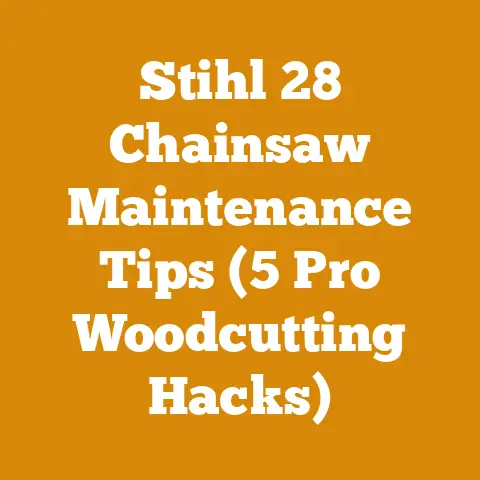Replace Chainsaw Bar: Adjust Sizes Safely (Expert Woodcutting Tips)
Replace Chainsaw Bar: Adjust Sizes Safely (Expert Woodcutting Tips)
I remember when my grandfather, a true old-school logger, finally traded his trusty axe for a chainsaw.
Even then, he was meticulous about every detail, especially the bar.
He always said, “A dull chain and a mismatched bar are a recipe for disaster, and disaster costs you time and money.” He wasn’t wrong.
Choosing the right chainsaw bar isn’t just about cutting wood; it’s about safety, efficiency, and ultimately, controlling your wood processing costs.
This article dives deep into selecting, replacing, and adjusting chainsaw bars, with a keen eye on the financial implications.
Understanding Chainsaw Bar Basics
Before we even think about sizes and costs, let’s get the fundamentals down.
The chainsaw bar, also known as the guide bar, is the metal blade that guides the chain around.
It’s the backbone of your cutting power.
The bar’s length determines the maximum diameter of wood you can safely cut.
Types of Chainsaw Bars
There are primarily three types of chainsaw bars, each with its own strengths and weaknesses:
- Laminated Bars: These are the most common type.
They are made of multiple layers of steel welded together.
Laminated bars are generally lighter and less expensive, making them ideal for occasional users and smaller chainsaws. - Solid Bars: Constructed from a single piece of steel, solid bars are more durable and resistant to bending.
They are preferred by professional loggers and those who frequently cut hardwoods. - Hard-Nose Bars: Similar to solid bars, but with a hardened tip.
This makes them even more resistant to wear and tear, especially when cutting dirty or abrasive wood.
Why Bar Length Matters
The bar length is directly related to the size of the engine.
Putting a bar that is too long on a chainsaw overloads the engine, causing it to wear out faster.
A bar that is too short limits the chainsaw’s capabilities.
Deciding When to Replace Your Chainsaw Bar
A chainsaw bar isn’t a lifetime purchase.
Several signs indicate it’s time for a replacement:
- Wear and Tear: Visible damage, such as bent rails, deep scratches, or a worn-out tip.
- Difficulty Maintaining Chain Tension: If you’re constantly adjusting the chain tension, it could mean the bar rails are worn.
- Uneven Cuts: If your chainsaw is cutting crooked even with a sharp chain, the bar might be bent or damaged.
- Excessive Vibration: This can indicate a problem with the bar’s balance or internal structure.
Choosing the Right Replacement Bar: A Step-by-Step Guide
Replacing a chainsaw bar seems simple, but it requires careful consideration.
Here’s how I approach it:
Step 1: Determine the Correct Bar Length
This is crucial.
The general rule is to use the bar length recommended by the chainsaw manufacturer.
This information is usually found in the owner’s manual or on a sticker on the chainsaw itself.
If you don’t have this information, measure the existing bar from the tip to where it enters the chainsaw body.
Step 2: Identify the Chain Pitch and Gauge
The chain pitch is the distance between three consecutive rivets divided by two.
The chain gauge is the thickness of the drive links that fit into the bar groove.
These measurements are crucial for ensuring the chain fits properly on the bar.
You can usually find this information stamped on the drive links of the chain.
If not, consult your chainsaw manual.
Step 3: Consider the Bar Mount
The bar mount is the part of the bar that attaches to the chainsaw.
Different chainsaw models have different bar mounts.
Make sure the replacement bar has the correct mount for your chainsaw.
Step 4: Choose the Bar Type
Based on your cutting needs, choose the appropriate bar type.
For occasional use, a laminated bar is fine.
For heavy-duty work, a solid or hard-nose bar is preferable.
Step 5: Select a Reputable Brand
Stick with reputable brands like Stihl, Oregon, Husqvarna, or Poulan Pro.
These brands are known for their quality and durability.
While it’s tempting to go with a cheaper, off-brand option, it’s usually not worth the risk.
A cheap bar might wear out quickly or even break, potentially damaging your chainsaw or causing injury.
Adjusting Bar Sizes Safely
Sometimes, you might want to experiment with different bar lengths to optimize your cutting performance.
However, this should be done with caution.
Understanding the Risks
Using a bar that is too long can overload the engine, causing it to overheat and wear out faster.
It can also make the chainsaw more difficult to control, increasing the risk of kickback.
Using a bar that is too short can limit the chainsaw’s capabilities.
Safe Adjustment Guidelines
- Consult the Owner’s Manual: Always check the owner’s manual for the recommended bar lengths for your chainsaw model.
- Stay Within the Recommended Range: If you decide to deviate from the recommended length, stay within a reasonable range (e.g., plus or minus 2 inches).
- Monitor Engine Performance: When using a different bar length, pay close attention to the engine’s performance.
If the engine is struggling or overheating, switch back to the recommended bar length. - Adjust Chain Tension: Make sure the chain tension is properly adjusted.
A loose chain can come off the bar, while a tight chain can cause excessive wear.
The Cost of Chainsaw Bars: A Detailed Breakdown
Now let’s get to the heart of the matter: the cost.
I’ve seen prices fluctuate wildly, and understanding the factors involved is key to budgeting effectively.
Factors Affecting Chainsaw Bar Costs
Several factors influence the price of a chainsaw bar:
- Bar Length: Longer bars are generally more expensive than shorter bars.
This is because they require more materials and manufacturing effort. - Bar Type: Solid and hard-nose bars are typically more expensive than laminated bars due to their superior durability.
- Brand: Reputable brands like Stihl and Oregon tend to charge more than lesser-known brands.
- Features: Some bars have special features, such as replaceable sprockets or laser-etched markings, which can increase the price.
- Retailer: Prices can vary depending on where you buy the bar.
Online retailers often offer lower prices than brick-and-mortar stores, but you might have to pay for shipping. - Material: The quality of steel used in the bar significantly affects the cost.
Higher-grade steel is more durable and resistant to wear, but it also costs more.
Average Chainsaw Bar Prices (Data-Driven)
To give you a better idea of what to expect, here’s a breakdown of average chainsaw bar prices:
- Laminated Bars (16-20 inches): $25-$50
- Solid Bars (16-20 inches): $50-$100
- Hard-Nose Bars (16-20 inches): $75-$150
- Longer Bars (24-36 inches): $100-$300+
Data Source: These figures are based on a compilation of prices from major retailers like Amazon, Lowe’s, Home Depot, and specialty chainsaw supply stores, as of late 2024.
I regularly check these prices and update my estimates accordingly.
Cost Comparison: Brand vs. Generic
I’ve done my own side-by-side comparisons of branded and generic bars.
Here’s what I found:
Insight: While generic bars are cheaper upfront, the difference in durability and lifespan often makes branded bars a better long-term investment.
Plus, the precise chain fit reduces wear on your chain, saving you money on chain replacements.
The Hidden Costs of a Cheap Chainsaw Bar
Don’t be fooled by the initial savings of a cheap chainsaw bar.
It can end up costing you more in the long run.
- Increased Chain Wear: A poorly made bar can cause the chain to wear out faster, requiring more frequent replacements.
- Reduced Cutting Efficiency: A bent or damaged bar can reduce cutting efficiency, requiring more time and effort to complete your wood processing tasks.
- Increased Fuel Consumption: A dull or inefficient bar can cause the engine to work harder, resulting in increased fuel consumption.
- Potential for Damage: A cheap bar might break or fail, potentially damaging your chainsaw or causing injury.
- Downtime: Spending time replacing a broken bar or dealing with a malfunctioning chainsaw translates to lost productivity, which has a real monetary value, especially if you’re working on a deadline.
DIY vs. Professional Replacement: Cost Considerations
Replacing a chainsaw bar is a relatively simple task that most people can do themselves.
However, if you’re not comfortable working with power tools or if you’re unsure about any of the steps, it’s best to take it to a professional.
- DIY:
- Cost: $0 (assuming you have the necessary tools)
- Time: 30-60 minutes
- Risk: Potential for injury or damage to the chainsaw if not done correctly.
- Professional:
- Cost: $20-$50 (depending on the shop)
- Time: 1-2 days (including drop-off and pick-up)
- Risk: Minimal risk of injury or damage.
My Recommendation: If you’re comfortable with basic mechanical tasks, replacing the bar yourself is a great way to save money.
However, if you’re unsure, it’s worth paying a professional to do it.
Budgeting for Chainsaw Bar Replacements
Proper budgeting is key to keeping your wood processing costs under control.
Here’s how I plan for chainsaw bar replacements:
Estimating Replacement Frequency
The lifespan of a chainsaw bar depends on several factors, including the type of bar, the type of wood you’re cutting, and how often you use the chainsaw.
As a general rule, I replace my bars every 1-3 years with moderate to heavy use.
If you only use your chainsaw occasionally, you might be able to get away with replacing the bar every 5 years or so.
Creating a Replacement Schedule
Based on your estimated replacement frequency, create a replacement schedule.
This will help you plan your budget and avoid unexpected expenses.
Setting Aside Funds
Set aside funds each month to cover the cost of chainsaw bar replacements.
This will ensure that you have the money available when you need it.
Leveraging Discounts and Sales
Keep an eye out for discounts and sales on chainsaw bars.
Many retailers offer discounts during holidays or special events.
You can also sign up for email newsletters to receive notifications about sales.
Cost Optimization Strategies for Chainsaw Bars
Here are some practical tips for optimizing your chainsaw bar costs:
- Proper Maintenance: Regularly clean and lubricate your chainsaw bar to extend its lifespan.
I use a bar and chain oil designed for high-speed chainsaws. - Sharpen Your Chain: A sharp chain reduces the strain on the bar, prolonging its life.
I sharpen my chain every few hours of use. - Avoid Cutting Dirty Wood: Cutting dirty or abrasive wood can cause the bar to wear out faster.
Try to avoid cutting wood that is covered in dirt, sand, or gravel. - Use the Correct Chain Tension: Too much tension can cause excessive wear, while too little tension can cause the chain to come off the bar.
- Store Your Chainsaw Properly: When not in use, store your chainsaw in a dry, protected area.
This will prevent the bar from rusting or corroding. - Rotate Your Bars: If you have multiple chainsaws, rotate the bars between them to distribute the wear evenly.
- Consider Refurbishing: In some cases, you can refurbish a worn chainsaw bar by filing down the rails and cleaning the groove.
This is a cost-effective alternative to replacing the bar.
Data-Backed Insights on Timber Prices and Equipment Rental
Understanding broader trends in the timber industry can also inform your chainsaw bar budget.
Here’s what I’ve learned from tracking timber prices and equipment rental fees:
Timber Price Fluctuations
Timber prices can fluctuate significantly depending on factors such as:
- Wood Species: Hardwoods like oak and maple are generally more expensive than softwoods like pine and fir.
- Wood Quality: Higher-quality timber with fewer knots and defects commands a higher price.
- Market Demand: Increased demand for timber can drive up prices.
- Location: Timber prices can vary depending on the region.
- Seasonality: Timber prices tend to be higher during the winter months when logging is more difficult.
Data Source: According to the Forest Resources Association, timber prices in the US have increased by an average of 5% per year over the past decade.
However, prices can vary significantly depending on the specific region and wood species.
I use this information to adjust my wood purchasing budget accordingly.
Equipment Rental Fees
If you only need a chainsaw for occasional use, renting might be a more cost-effective option than buying.
Here are some average equipment rental fees:
- Chainsaw Rental (per day): $30-$50
- Chainsaw Rental (per week): $100-$200
Data Source: These figures are based on a survey of equipment rental companies in my area.
Prices can vary depending on the chainsaw model and the rental company.
Case Study: Budgeting for a Firewood Project
Let’s look at a real-world example of how to budget for a firewood project, including chainsaw bar costs.
Project: Cutting and splitting 5 cords of firewood.
Assumptions:
- I already own a chainsaw and splitter.
- I’m cutting softwood (pine).
- I’m doing the work myself.
- I estimate it will take me 20 hours to complete the project.
Cost Breakdown:
- Timber Purchase: $200 (assuming I can get the wood for $40 per cord)
- Fuel: $50 (for the chainsaw and splitter)
- Chainsaw Bar: $0 (I already have a bar in good condition)
- Chain Sharpening: $10 (for sharpening the chain)
- Bar and Chain Oil: $20
- Gloves and Safety Gear: $30 (if needed)
Total Cost: $310
Cost per Cord: $62
Insight: By carefully tracking my expenses, I can accurately determine the cost per cord of firewood.
This information helps me make informed decisions about pricing and profitability.
Calculations and Formulas for Wood Processing
Understanding some basic calculations and formulas can help you estimate costs and optimize your wood processing efforts.
Calculating Board Feet
Board feet is a unit of measurement for lumber.
One board foot is equal to 144 cubic inches (12 inches x 12 inches x 1 inch).
To calculate the number of board feet in a log, you can use the following formula:
Estimating Drying Time
The drying time for firewood depends on several factors, including the wood species, the size of the pieces, and the climate.
As a general rule, hardwoods take longer to dry than softwoods.
You can estimate the drying time using the following guidelines:
- Softwoods: 6-12 months
- Hardwoods: 12-24 months
Insight: Proper drying is essential for efficient burning.
Wet firewood produces less heat and more smoke.
Actionable Takeaways and Next Steps
Here are some actionable takeaways and next steps for readers planning wood processing or firewood projects:
- Assess Your Needs: Determine the type of wood you’ll be cutting and the frequency of use to choose the right chainsaw bar.
- Research Prices: Compare prices from different retailers to find the best deal.
- Create a Budget: Develop a detailed budget that includes all relevant expenses, including chainsaw bar costs.
- Implement Cost Optimization Strategies: Follow the tips outlined in this article to minimize your costs.
- Track Your Expenses: Keep a record of all your expenses to accurately determine the cost of your wood processing projects.
- Stay Informed: Stay up-to-date on the latest trends in the timber industry to make informed decisions about pricing and profitability.
Conclusion: Mastering Chainsaw Bar Costs for Woodworking Success
Replacing a chainsaw bar is a necessary part of wood processing, and understanding the costs involved is crucial for budgeting effectively.
By following the tips and guidelines outlined in this article, you can choose the right bar, optimize your costs, and ensure the success of your wood processing projects.
Remember, a little planning and attention to detail can go a long way in keeping your costs under control and maximizing your profits.
As my grandfather always said, “Take care of your tools, and they’ll take care of you.” And in the world of wood processing, that translates directly to taking care of your bottom line.






